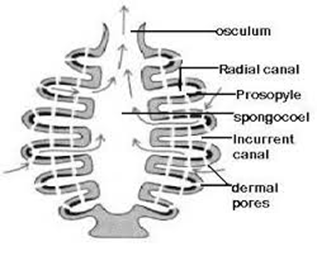Aurelia Aurita Life Cycle: Characterstics, Classification
Aurelia
Aurelia aurita is a type of zooplankton found all over the world. They are see-through and don't have eyes, brains, or hearts. They're usually between 2 to 15 inches wide. Even though they prefer being alone, they get carried together in groups called Blooms by wind and water currents. At night, they look like they're moving through the water like jellyfish, which is why they're sometimes called "jellyfish".
They have four reproductive organs surrounded by tentacles in their top part. Their body color changes based on what they eat, so they can be blue, pink, or other colors. Let's learn more about Aurelia in detail.
Details Of Aurelia Diagram -
- Body: The center of the diagram would display the jellyfish's bell-shaped body, often called the "umbrella."
- Tentacles: Below the bell, you'd see long, hair-like tentacles extending outward.
- Oral Arms: The oral arms are used for catching and eating food.
- Mouth: Near the center's underside, there is a simple depiction of the mouth.
- Nerve Net: A simplified representation of the jellyfish's nerve system, spread throughout its body.
Classification of jellyfish or Aurelia -
Phylum - Coelantrate
Class - Scyphozoa
Order- Semaeostomae
Family - Ulmaridae
Genus -Aurelia
Species - aurita
Characteristics -
- They are marine animals found mostly in warm and temperate seas.
- They are carnivores in nature.
- They are also known as Moon jelly or jellyfish.
- They are coated with the mucous that helps to collect prey.
- They generally feed on mollusk and plankton with the help of their medusa.
- Their body appears like an umbrella.
- They follow the alternation of generations in their life cycle.
- They have four horseshoe-shaped gonads seen in the middle of the dome which is surrounded by tentacles.
- These tentacles are lined with nematocytes that help to kill prey.
- They are dioecious animals.
- Moon jellyfish typically live for about six months to one year.
- Moon jellyfish don't usually hurt people with their stings, so they're one of the jellyfish you can safely come across.
Life Cycle of Aurelia aurita or Jelly Fish -
Fertilization: In Aurelia, water is the fertilizing medium. Sperm and eggs are released from the body and move towards each other in the flowing water. They meet and fertilize in the female's body. Fertilization in Aurelia can happen inside the body or outside.
Formation of planula larva: During early development, the zygote changes into a moving larval form called a "planula larva" within the frilly parts of the oral arms. To achieve this, the zygote goes through divisions that create a solid ball-like structure called a "morula." This morula then transforms through more cell divisions into a hollow structure with fluid inside, known as a "blastula." Next, a process called invagination occurs, forming a two-layered structure called a "gastrula." This gastrula has an inner layer called "endoderm" and an outer layer called "ectoderm." The opening of the gastrula, called the "blastopore," is partially open. As the embryo grows longer and tiny hair-like structures called "cilia" appear on its outer cells, the blastopore eventually closes. This larval stage with cilia is referred to as a "planula larva."
Formation of scyphistoma: The larva of the ciliated planula is attached to a surface via its aboral end. After the attachment, the larva loses its cilia, and the oral end grows into a mouth. At this point, the larva transformed into a little polyp with a trumpet-like shape. Tentacles appear around the mouth. The mouth takes on a square shape, and the edges of the mouth lengthen to form a short manubrium. A young scyphistoma or hydratuba is the term now used to describe this larva. At this stage, Scyphistoma eats, grows, and survives for several months. It also exhibits budding and the complete separation of the buds from the parent.
Ephyra: A newly discovered creature called ephyra has a jelly-like body. The parts that stick out from its center have a nice pattern. It has eight deep cuts on the edge of its round body that split the eight parts into two sections. At the end of each part, there are two pairs of flaps that can sense things, and there's a small arm growing between these flaps. It also has a central part with a mouth that has four corners. When the ephyra is moving in the sea, it eats tiny living things like protozoans.
Formation of ephyrae: The development of ephyrae from scyphistoma is known as strobilation. In the fall and winter, Scyphistoma undergoes strobilation. Distally, the scyphistoma creates a series of transverse constrictions that resemble rings. These constrictions were gradually increasing deeper, until the creature now looked like a stack of tiny discs stacked one on top of the other. At this stage, the segmented scyphistoma is known as a strobili, and each of the body segments is known as an ephyra larva.
Ephyra: A newly discovered creature called ephyra has a jelly-like body. The parts that stick out from its center have a nice pattern. It has eight deep cuts on the edge of its round body that split the eight parts into two sections. At the end of each part, there are two pairs of flaps that can sense things, and there's a small arm growing between these flaps. It also has a central part with a mouth that has four corners. When the ephyra is moving in the sea, it eats tiny living things like protozoans.
Metamorphosis: As the middle jelly layer forms and the inner layers meet, a strong stomach lining is made. Afterward, Ephyra turns into an adult Aurelia, which has four arms near its mouth and side tentacles.






Nice POst
ReplyDelete